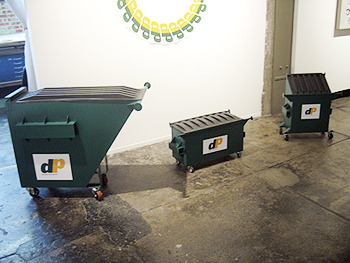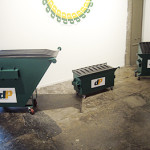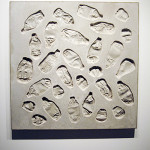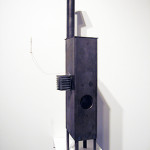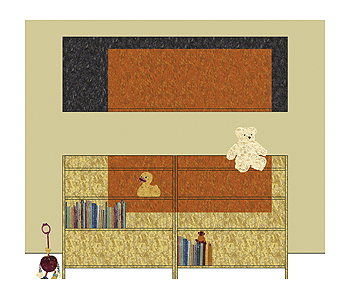The centerpieces of Daniel Petraitis’ exhibition Waste Management at Kelly & Weber Fine Art are five scaled-down dumpsters that replicate the construction and feel of their larger relatives so effectively that many viewers fail to see them as sculptural art objects. People open the lids and push them around as if testing them out in a showroom. Drawing heavily from Pop Art, the dumpsters are accessible to viewers of every stripe. Their more than convincing fabrication immediately suggests a model for a mass produced consumer object. Unfortunately, much of the message of personal responsibility is lost due to the charming qualities these undersized dumpsters posses.
Responding to the refined nature of his work’s appearance in contrast to his overarching themes on waste, Petraitis says that he wants his work to be “the opposite of Minimalism – handmade but that it doesn’t look handmade,” which is certainly achieved with the dumpsters. Petraitis’ meticulous attention to craft subverts the Minimalists’ exclusion of the artist’s gesture by becoming so refined as to be almost unnoticeable. Additionally, much of the work in Waste Management embraces and extends the contemporary fascination with the Minimalist movement’s forms and the cool nature of such work.
Fossils consists of two approximately 3’ x 3’ cast concrete panels with the impressions of discarded water bottles. They humorously combine and elevate the cast off objects with the place of their discard, starkly but gently forcing the viewer to question their own use and disuse of easily ignored things and places. Similarly relying on repetition and the ubiquitous grid, Scrappers documents those in the community who have active roles in cleaning up the discarded. Framed in handmade scrap-wood frames, Scrappers presents four sets of twenty 4” x 6” photos of beaten-up pick-up trucks laden with refuse. These are arranged in a five down and four across grid with each truck seen from the side. The scrap metal and wood filling the rusty pick-ups echo Petraitis’ framing of his subjects - each just fitting, although somewhat awkwardly. Despite the empathy evoked for those who struggle to make a living this way, the series ultimately feels optimistic. The scrappers represent a mindset and a course of action that society is moving towards - thinking of waste and its handling as an important aspect within the world.
Petraitis’ subtle castigation of those who can’t be bothered to treat their surroundings with respect juxtaposed with those who eke out a living regarding waste as an important resource is only one example of his work’s core objective of attempting to initiate the viewer to question their role in the cycle of production. Through varied forms and techniques, Petraitis tackles every facet of waste - its production, use, and paraphernalia - in order to highlight its’ implications for an individual as well as for society. He is also fully aware of the difficulty and contradictions of posing these questions though the bullhorn of art, which he himself has called “a waste of materials.” Eventually we must all choose how to allocate our resources, time and energy. Thankfully, more and more people are choosing to embrace re-use, a DIY ethos, and environmentally friendly actions. But is a shiny surface of positive effort enough in an energy hungry world? Does carrying a shop tote erase the energy bill of a mansion in which only two people live?
Mostly eschewing formal aesthetics in favor of direct interaction, the works Incinerator and Controlled Waste bluntly confront the viewer with these complex questions. Each is a sculpture that exaggerates energy usage to an absurd extreme so as to straightforwardly allow the viewer to exercise their power of choice concerning that usage. Resembling a pathetic Bernd and Hilla Becher industrial building, Incinerator is a tiny functional factory that provides 2.5 Watts to a small feeble light bulb but at the seemingly out-of-whack temperature of 450 degrees Fahrenheit. Controlled Waste turns the ironic thought of consciously controlling the act of wasting into a dark entertainment of sorts. An elegant square assembly of MDF, wires, glass tubes, and filament is wired straight into the gallery’s electrical junction box. Also connected is a large button for the viewer to push. It silently begs to be activated and its wasteful reward is the orange glow of the four glass encased elements for just a few moments. One overly excited viewer at the show’s opening stood there and repeatedly pushed the button until the piece ceased functioning; a demented but all too common example of how we perceive energy use.
Switching modes again, the work The Surface Of… has Petraitis deftly combining the most effective qualities present within the rest of the work on view. It is a simple elegant form of chrome, at once curvilinear and sharp, as if metal could be pulled like so much taffy. With a Brancusi-like gesture it wings off the wall, curving and pointing, only to have its other tip come back to rest on the same surface. The chrome facade drinks in the dark concrete of the floor and ceiling, while simultaneously reflecting the bright, hot lights of the gallery. It is smoldering desire condensed into an austere seductive object - and it is simply a salvaged, chromed car fender.
There is a trick and a lie contained in Waste Management’s work, certainly in the seductiveness of The Surface Of…, or the in the likeable character of the dumpsters. Once exposed, the larger revelation is that we love our stuff! More shockingly we love our trash! What Petraitis principally asks of us is that the focus of our actions and attentions be aimed on that which is necessary, that which furthers the “consideration [given]to the way people conduct their lives.” Petraitis evidently sees much of our culture, and the objects we give fleeting affection, as things sold to us by rebranded corporate identities. He attempts to operate outside of this paradigm, choosing to direct his energies toward a love of making things, despite the contradictions. Let’s hope that he continues to waste his time making things that are as intriguing as those presented here.
- Daniel Petraitis, Dumpster, Mixed Media, 2008.
- Daniel Petraitis, Fossils, Cast Concrete, 2008.
- Daniel Petraitis, Incinerator, Mixed Media, 2008.
“Waste Management” is on view until July 6 at Kelly & Weber Fine Art located at 1400 N. American St., Suite 201 in Philadelphia.
All artist quotes via artist interview courtesy of Studioscopic.
All images are courtesy the author, artist, and Kelly & Weber Fine Art.

